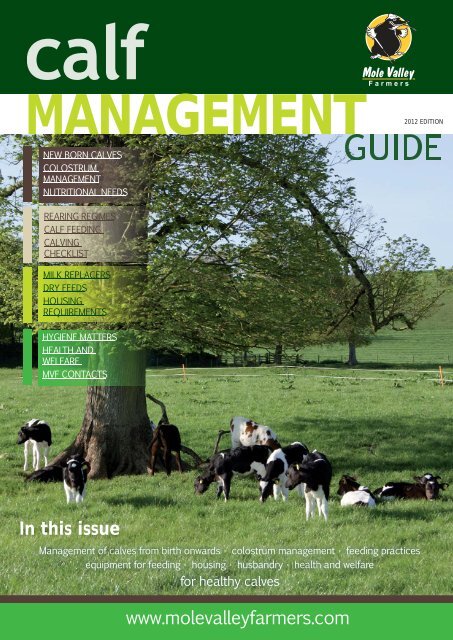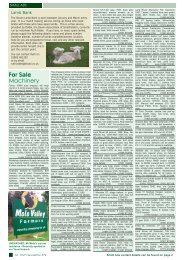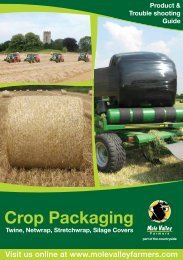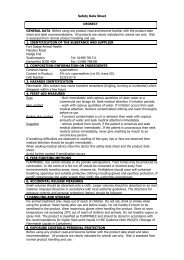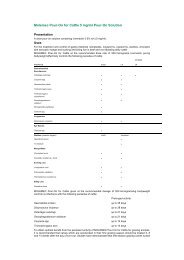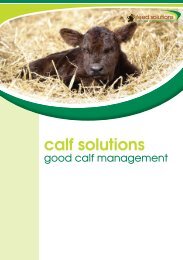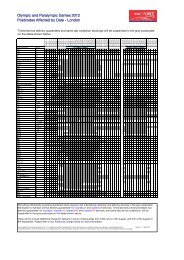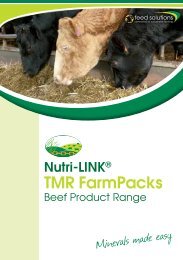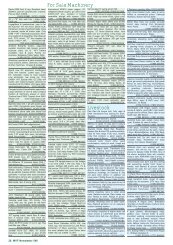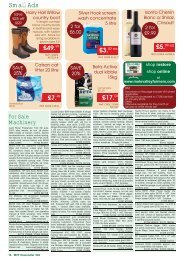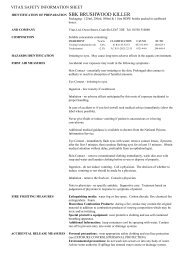MoleValley Calf - Mole Valley Farmers
MoleValley Calf - Mole Valley Farmers
MoleValley Calf - Mole Valley Farmers
Create successful ePaper yourself
Turn your PDF publications into a flip-book with our unique Google optimized e-Paper software.
2012 CALF MANAGEMENT GUIDE | MOLE VALLEY FARMERS<br />
MANAGEMENTT 2012<br />
NEW BORN CALVES<br />
COLOSTRUM<br />
MANAGEMENT<br />
NUTRITIONAL NEEDS<br />
REARING REGIMES<br />
CALF FEEDING<br />
CALVING<br />
CHECKLIST<br />
MILK REPLACERS<br />
DRY FEEDS<br />
HOUSING<br />
REQUIREMENTS<br />
HYGIENE MATTERS<br />
HEALTH AND<br />
WELFARE<br />
MVF CONTACTS<br />
In this issue<br />
www.molevalleyfarmers.com<br />
EDITION<br />
D<br />
Management of calves from birth onwards • colostrum management • feeding practices<br />
equipment for feeding • housing • husbandry • health and welfare<br />
for healthy calves<br />
1
2<br />
MOLE VALLEY FARMERS | CALF MANAGEMENT GUIDE 2012<br />
Introduction<br />
Adam May, Agricultural Commercial Manager<br />
07818 017116<br />
The fi rst few months in a calves’ life will<br />
determine whether it will deliver its full<br />
genetic potential, or fall some way short, due<br />
to poor feed or disease. Over recent years, research has shown<br />
how much infl uence a good diet and health plan can have on<br />
the lifetime performance of both dairy and beef cattle.<br />
Every aspect in the calf rearing process needs to be carefully planned<br />
and implemented, from ensuring it gets a good feed of colostrum at<br />
birth, through the milk feed period, to the transition to solid feed, not to<br />
mention the environment and health planning needed if the best results<br />
are to be achieved.<br />
In this supplement we have brought together a comprehensive array of<br />
articles, submitted by some of the best experts in the fi eld, as well as<br />
utilising the expertise we have within the company.<br />
We are grateful to Dr Jessica Cooke, Young Animal Technical Specialist and<br />
Will Sinclair, <strong>Calf</strong> Specialist, from Volac International, Tim Porter MRCVS<br />
from Westpoint Vets and our own Patrick Traill for the support they have<br />
given us in the preparation of this publication.<br />
We also have articles of housing, health planning, feeding guides, and<br />
many others, which are important to the wellbeing of the young calf.<br />
The damage which can be done to the young calf’s internal organs is<br />
often underestimated and can be irreparable, which results in an underperforming<br />
adult animal.<br />
We hope you fi nd the contents interesting and informative. If you need any<br />
further advice or information, please contact me.<br />
Colostrum management tips<br />
Colostrum of the right quality and quantity, given to the calf at the right<br />
time is the cornerstone of success for any calf rearing enterprise. It<br />
supplies both essential nutrients and antibodies.<br />
A new-born calf has no protective<br />
antibodies to resist disease challenges<br />
and these can only be absorbed via<br />
colostrum. Poor health, low growth rates<br />
and high mortality are most often seen<br />
in calves that have received inadequate<br />
colostrum. The following information<br />
states the 4 golden rules (4 Q’s) when<br />
feeding colostrum:<br />
1. Quality<br />
Feed calves with good quality colostrum,<br />
ideally from mature cows. Colostrum<br />
quality varies widely from cow to<br />
cow. Colostrum from cows in their<br />
fi rst lactation usually contains fewer<br />
antibodies to help protect against<br />
diseases as these animals have not<br />
yet been exposed to a wide range of<br />
pathogens.<br />
Good quality colostrum may be frozen for<br />
future use, when suitable colostrum is<br />
not available from the dam. Alternatively,<br />
if considering the use of a commercial<br />
alternative (for example Volac<br />
Volostrum), ensure that the product has<br />
been independently tested and is proven<br />
to be successful.<br />
It is diffi cult to visually detect if<br />
colostrum contains suffi cient antibodies.<br />
It is therefore recommended that<br />
colostrum quality is tested using<br />
a colostrometer, which is a simple<br />
apparatus that can be used on farm to<br />
give an indication of the quality.<br />
2. Quantity<br />
Feed a minimum of 3 litres (6 pints) in<br />
the fi rst six hours, split into two feeds if<br />
necessary. A further 3 litres should be fed<br />
within 12 hours. A calf receiving at least<br />
3 litres of good quality colostrum in the<br />
fi rst six hours of life will have received<br />
suffi cient antibodies. Remember, a calf<br />
requires approximately 20 minutes of<br />
continuous suckling to consume 3 litres of<br />
milk from the cow.<br />
MVF Farmer Shareholder Scheme<br />
If you see this symbol, it means the<br />
product qualifes for MVF Farmer<br />
Shareholder benefits.<br />
To find out more about an MVF<br />
Farmer Shareholder account call<br />
our Membership Team on<br />
01769 573431.<br />
3. Quickly<br />
Feed colostrum as soon as possible<br />
after birth and at latest within the<br />
fi rst six hours. At birth, the calf gut<br />
is permeable, which means that it can<br />
absorb the large antibody molecules<br />
directly into its bloodstream. Over the<br />
fi rst 24 hours the gut rapidly ‘closes’<br />
and these molecules can no longer<br />
be absorbed. For good immunity, low<br />
mortality and future health, it is essential<br />
that the calf absorbs suffi cient antibodies<br />
as soon as possible after birth before the<br />
gut ‘closes’.<br />
Feeding colostrum for at least the fi rst<br />
three days of life has been shown to have<br />
other benefi ts as it encourages rapid gut<br />
development and lays a solid foundation<br />
for fast effi cient healthy growth.<br />
4. Quietly<br />
Research has proven that calves that are<br />
stressed when receiving colostrum will<br />
not absorb the protective antibodies as<br />
effi ciently as those that are calm. This<br />
means that a stressed calf would require<br />
more colostrum in order to achieve the<br />
same level of immunity as a calf which<br />
was not stressed.
New born calves -<br />
meeting their nutrient<br />
requirements<br />
Article by<br />
Dr Jessica Cooke,<br />
Young Animal<br />
Technical Specialist,<br />
Volac International<br />
After colostrum, the next critical feed for<br />
the new-born calf is milk, writes Volac’s<br />
Dr Jessica Cooke. New born calves, like<br />
infants, have a requirement for milk in their<br />
diet until such time as their digestive system<br />
matures and they can digest more complex<br />
feeds.<br />
Whilst the digestive system of the calf develops<br />
relatively quickly, the abomasum (fourth stomach),<br />
still plays the most signifi cant role in digestion for at<br />
least the fi rst three weeks of life. During this period,<br />
milk bypasses the largely non-functioning rumen and<br />
goes straight into the abomasum where acids and<br />
enzymes are secreted to aid digestion. See Fig 1.<br />
Whatever is fed, the physiology of the calf dictates<br />
that, for the fi rst three weeks of life, it is almost<br />
entirely dependent on the liquid milk feed to supply<br />
the nutrients it needs to support health and growth.<br />
Supplying energy<br />
Young calves require energy for normal body<br />
functions such as digestion, respiration and heat<br />
production as well as for growth, and the energy<br />
available to the calf is directly proportionate to the<br />
supply of milk or milk replacer during the fi rst three<br />
weeks.<br />
So, which source of energy is best? Although milk<br />
replacers only contain 14% to 20% fat, compared<br />
Fig 1: Development of the four compartments of the calf’s stomach area<br />
2012 CALF MANAGEMENT GUIDE | MOLE VALLEY FARMERS<br />
<strong>Calf</strong> nutrition<br />
with whole milk at 30% to 32% fat, the lactose content in milk also provides<br />
energy. In total, the proportion of energy supplied by the fat and lactose is<br />
similar for whole milk, skim or whey based milk replacers - over 72%, so all<br />
can provide valuable energy to the calf. See Fig 2.<br />
Fig 2: Relative proportion of energy supplied by different<br />
components in milk or milk replacer.<br />
By supplying more lactose and less fat compared with whole milk, calf milk<br />
replacers typically stimulate earlier intake of solid feed which encourages<br />
earlier rumen development. Feeding whey based milk replacers, which do<br />
not form a clot in the abomasum, can increase early solid feed intake in<br />
comparison with high quality skim based milks.<br />
The fat in whole milk is highly digestible, and well formulated milk replacers<br />
contain a blend of fat sources which are designed to be well digested by<br />
the calf and provide energy and nutrients to help maintain good health<br />
and growth. The processing of the<br />
fats in milk replacers for example<br />
by homogenisation, also has a very<br />
signifi cant impact on the energy<br />
delivered to the calf.<br />
There are occasions when the calf’s<br />
energy requirements are higher, for<br />
example when targeting higher growth<br />
rates, or in periods of cold weather<br />
when the calf needs more energy to<br />
maintain growth. Energy intake can be<br />
improved in various ways but, as shown<br />
in Table 1, increasing the oil content of<br />
the milk replacer from 16% to 20% has a<br />
negligible effect compared with simply<br />
feeding more of the same.<br />
continued on page 4<br />
3
4<br />
MOLE VALLEY FARMERS | CALF MANAGEMENT GUIDE 2012<br />
<strong>Calf</strong> nutrition<br />
continued from page 3<br />
The ash content of a milk replacer contributes<br />
nothing to the energy supply, so the ideal ash<br />
content is similar to that found in cows’ milk at<br />
approximately 6%.<br />
Supplying proteins<br />
Whole milk is 26% to 27% protein, while milk<br />
replacers typically contain 20% to 27% protein.<br />
Calves have a requirement for protein, a minimum<br />
of 20% in the diet, but they also require specifi c<br />
Table 1: Daily energy intake and the effect<br />
of feeding a low vs high oil milk replacer, or<br />
feeding different volumes or concentrations<br />
Energy<br />
supplied/calf<br />
per day (MJ)<br />
16% oil<br />
22% protein<br />
20% oil<br />
22% protein<br />
4 litres - 12.5% 7.5 7.8<br />
4 litres - 15% 11.2 11.7<br />
5 litres - 12.5% 11.7 12.2<br />
amino acids - the building blocks of protein. The<br />
total quantity and balance of amino acids, not crude<br />
protein %, are the keys to muscle development and<br />
calf growth, but only the protein % is declared on<br />
the product label so it is impossible to judge likely<br />
animal performance from reading the label alone.<br />
Overall - should I feed my calf whole<br />
milk or milk replacer?<br />
Whole milk can provide a high level of energy and<br />
protein (amino acids), to the calf but it can also:<br />
• transmit bacteria which infect the calf,<br />
including Johne’s, Salmonella, E.Coli<br />
• vary in nature which can lead to calf<br />
performance / health issues<br />
• ‘cost’ more than milk replacer. Milk is currently<br />
worth on average 29p/l if sold, compared with<br />
buying a milk replacer, which dependent on the<br />
quality purchased and mixing rates used can cost<br />
between 15p to 23p/l<br />
• result in delayed intake of solid feed, which can<br />
delay the age of successful weaning or result in<br />
post-weaning growth checks<br />
High quality calf milk replacers have to be<br />
purchased, but can provide a number of benefi ts<br />
including:<br />
• biosecurity – made using pasteurised milk<br />
• cheaper to feed per litre than whole milk<br />
• convenient and easy to use, and always available<br />
• lower fat, higher lactose – encouraging solid<br />
feed intake before and after weaning<br />
• formulated to provide a consistent supply of<br />
energy, protein, vitamins and trace elements<br />
that the calf requires<br />
Five ‘must haves’ when<br />
purchasing a milk replacer<br />
• Minimum of 20% protein declared<br />
• Maximum of 9% ash declared<br />
• Minimum 0.8% calcium<br />
• A trusted supplier<br />
• Previous calf performance and calf<br />
bloom give the best guarantee for the<br />
milk replacer’s quality<br />
why feed<br />
calf milk<br />
replacer?<br />
Advantages of<br />
feeding calf<br />
milk replacer<br />
More economic<br />
Continuity of<br />
nutrition<br />
Higher minerals<br />
and vitamins<br />
Better<br />
performance<br />
Reduced disease<br />
risk<br />
Accurate mixing<br />
Can be fed once<br />
a day<br />
Quicker weaning<br />
Economics of<br />
feeding calf<br />
milk replacer<br />
Milk price<br />
= 27.5ppl<br />
Powder price<br />
= 17.5ppl<br />
Cost difference =<br />
10ppl<br />
Milk intake per calf<br />
= 168 litres<br />
Cost difference<br />
per calf<br />
= £16.80
2012 CALF MANAGEMENT GUIDE | MOLE VALLEY FARMERS<br />
Rearing regimes Feeding equipment<br />
Bucket feeding (once or twice a day)<br />
Ideal for rearing a small number of calves at any one time. Allows<br />
good control over volume fed, and good supervision of animals, but<br />
is very labour intensive and calf growth may be limited.<br />
Non automated cold or warm ad-lib feeding<br />
Ideal for rearing small groups of calves. Low cost set up, with<br />
a lower labour requirement and greater fl exibility than bucket<br />
feeding. Calves grow well, but increased milk intake results in<br />
higher rearing costs and wetter bedding. Stockmanship skills need<br />
to be high as opportunity for ‘compulsory’ supervision is reduced.<br />
Automatic machine feeding<br />
Suitable system for larger farms. Allows 24 hours milk<br />
consumption, with low routine labour requirements, but increased<br />
set up costs (feeder hire or purchase). Maximises early calf growth<br />
but greater milk intake leads to increased urine production and<br />
wetter bedding. This system requires a high level of hygiene and<br />
good weaning management skills to allow maximum intake of<br />
starter pre-weaning.<br />
Computer controlled feeding<br />
Ideal for larger farms (over 100 cows). Allows ad-lib performance<br />
with the cost control of a restricted system. Each individual calf<br />
can be fed according to a pre-set programme to meet individual<br />
needs. The daily action list highlights behaviour changes and calves<br />
that might require attention. As weaning approaches, milk intake<br />
can be automatically reduced which encourages solid feed intake<br />
– this will minimise set-backs post weaning. High stockmanship<br />
standards are the key to success, and good housing (drainage and<br />
ventilation) is essential.<br />
Labour costs of feeding from<br />
birth to weaning<br />
Twice a day bucket feeding<br />
Once a day bucket feeding<br />
Cold ad-lib feeding<br />
Automatic feeding<br />
Computer controlled feeding<br />
115 mins<br />
£13.80<br />
70 mins<br />
£8.40<br />
40 mins<br />
£4.80<br />
20 mins<br />
£2.40<br />
20 mins<br />
£2.40<br />
Teat calf feeder<br />
<strong>Calf</strong> nutrition<br />
These feeders are designed for fast, effi cient group feeding of<br />
calves whilst maintaining an individual approach and promoting<br />
improved digestion of milk. Easy to clean and simple to maintain.<br />
Come complete with teats.<br />
Milk mixer<br />
90 and 200 litre capacity milk mixers are<br />
available to hire.<br />
Volac Mini-Mum warm milk calf<br />
feeder<br />
The Volac Mini-Mum feeder provides<br />
warm ad-lib feeding for groups of 4 to 6 calves. It is a robust<br />
moulded plastic feeder which is easy to operate and clean. Most<br />
importantly it will save you valuable time during the most labour<br />
intensive periods of the year, whilst allowing your calves to<br />
maximise their growth potential.<br />
Automatic feeder<br />
Automatically mixes and supplies warm milk replacer for up to 50<br />
calves, dramatically reducing the ‘man hours’ required for mixing<br />
milk and feeding calves, although a high degree of management<br />
skill is still essential. Automatic feeders are available for hire or<br />
purchase.<br />
Computerised calf feeders<br />
As featured on page 6, computerised calf feeders are designed to<br />
automatically mix milk (milk replacer or whole milk) and to control<br />
the feeding of each individually identifi ed calf, by restricting them<br />
to small portions of milk throughout the day.<br />
CONTACT KATIE GARDNER, CALF SPECIALIST, ON<br />
07539 226623<br />
Wydale<br />
twin calf bucket<br />
Wydale<br />
5 teat calf feeder<br />
Part of the range of Wydale calf<br />
feeders<br />
For more information on feeders<br />
contact your local branch or buy online<br />
at www.molevalleyfarmers.com<br />
5
6<br />
MOLE VALLEY FARMERS | CALF MANAGEMENT GUIDE 2012<br />
<strong>Calf</strong> nutrition<br />
Machine feeding<br />
Feeding calves on machines has been<br />
around for 40 years, initially using ad-lib<br />
feeders and, for some 20 years now, feeders<br />
controlled by a computer.<br />
Although ad-lib feeders will save labour, and give<br />
fl exibility in time required to manage calves, they<br />
have serious drawbacks when trying to control<br />
costs and ensure that enough concentrate is being<br />
consumed at weaning.<br />
Controlling costs whilst at the same time as<br />
achieving higher growth rates, without risk of<br />
digestive upset is where the computer feeder really<br />
comes into its own. Feed plans set in the computer<br />
are designed to feed calves carefully measured<br />
quantity’s several times a day, thereby allowing<br />
higher rates of feeding and ensuring that higher<br />
growth rate targets are met, without causing upsets,<br />
whilst at the same time saving labour.<br />
The latest computer feeder from Volac International,<br />
the Forster Technik Vario Plus, offers the opportunity<br />
to manage your calf rearing enterprise, both in<br />
terms of feed and labour costs. Management of<br />
the calf is very simple, as all relevant feeding<br />
information is available on an easy to use hand held<br />
terminal. Minute by minute details are given on<br />
the amount of milk available, how much has been<br />
consumed, and what was the relevant drinking<br />
speed of the calf, and any breaks to feeding the<br />
calf. This information is displayed along with the<br />
details from the day before, so that you can make<br />
an accurate judgement on a calf’s wellbeing on that<br />
particular day. Warning lists are given for deviations<br />
from a calf’s normal feeding pattern, alerting the<br />
stockperson to potential problems.<br />
Forster Technik Vario +<br />
There are many key features to the Vario Plus feeder, with one of the most<br />
signifi cant being the Automatic calibration scales, where water and powder<br />
are weighed regularly throughout the day as the milk is being prepared, to<br />
ensure that the correct concentration is dispensed according to the feed plan.<br />
Automatic wash functions, not only keep the feeder clean, but also help to<br />
reduces labour.<br />
The Vario Plus feeder will comfortably feed 30 calves per feed-station, and is<br />
capable of feeding 120 calves on 4 stations. Feed training pump will assist in<br />
getting calves to drink from teat, and most will only require taking to the teat<br />
once or twice before they will feed themselves.<br />
There are many benefi ts to rearing calves on computer feeders, where they are<br />
in social groups with room to roam, plus there is not the same labour demand in<br />
washing large numbers of pen sides or feeding equipment. For more information<br />
on benefi ts of computer feeders.<br />
CONTACT KATIE GARDNER, CALF SPECIALIST<br />
ON 07539 226623<br />
Help from a computerised calf feeder<br />
The need for larger numbers of stock on both dairy and beef farms, are putting more<br />
pressures on the valuable resource of labour.<br />
The most common reason for failing to meet specifi c targets or objectives is that there is<br />
never enough time. No other system typifi es this more than the calf rearing enterprise. This<br />
is true for both dairy farms who would like to be achieving earlier calving dates with their<br />
heifers, or beef farmers wanting to grow calves faster to reduce days to slaughter, or days in<br />
the rearing unit in the case of the specialist calf rearer.<br />
For decades now, the most common rearing system used, is twice a day feeding using<br />
buckets, or teat feeders. However, there are several drawbacks with this approach. Firstly,<br />
there is the need to have regular feeding times, irrespective of what<br />
other demands there are for the stockpersons time. Also with the need<br />
to grow animals faster, it is challenging to ensure that we can get more<br />
milk and feed into the calf, without causing any digestive upsets. Finally,<br />
the need to wash a large number of utensils. Thankfully, help is at hand<br />
in the form of the computerised calf feeder.<br />
Will Sinclair, Volac International
Calving and looking after young calves<br />
All you need from <strong>Mole</strong> <strong>Valley</strong> <strong>Farmers</strong><br />
Give your youngstock the best start in Life<br />
The use of hutches has become a proven method of rearing calves.<br />
Preventing pneumonia and scours at an early age is essential to an<br />
animals’ future productivity. Animals with damaged lungs will not achieve<br />
their lifetime milk yield potential and beef animals will take longer to<br />
fi nish.<br />
Calves reared outdoors in hutches, thrive on individual attention and<br />
receive individual feeds which can be monitored more effectively. Natural<br />
outdoor ventilation eliminates the spread of viruses and infections such as<br />
pneumonia and scour.<br />
Whether you are rearing dairy herd replacements, embryos worth<br />
thousands of pounds or beef calves, you will benefi t from bigger, healthier<br />
calves at weaning, reducing veterinary/drug costs and calf mortality by<br />
using hutches.<br />
Calving checklist<br />
FEEDING<br />
MEDICAL<br />
Feeders and teats<br />
Jug and whisk<br />
Buckets<br />
<strong>Calf</strong> colostrum<br />
Milk replacer<br />
Stomach tube<br />
Syringes<br />
Needles / sharps containers<br />
Calcium bolus/ Botonic calcium<br />
Pessaries<br />
Surgical scrub<br />
Obstetrical gel<br />
Roto Corona syringes<br />
Iodine<br />
Calciject<br />
Glucose<br />
EQUIPMENT / SUNDRIES<br />
Vink calving jack<br />
Ropes / rope handles<br />
Apron<br />
Disinfectant<br />
Dehorner and gas<br />
Ear tags<br />
Arm length gloves<br />
Products to consider ....<br />
Collate whole<br />
colostrum<br />
for calves<br />
228g<br />
Net Tex<br />
<strong>Calf</strong> Stomach<br />
Tube<br />
Ritchey Superlube<br />
thick gel<br />
Horn'Up<br />
rechargeable<br />
dehorner<br />
Iodine 10% BP<br />
2.5L<br />
2012 CALF MANAGEMENT GUIDE | MOLE VALLEY FARMERS<br />
Equipment<br />
<strong>Calf</strong> hutches available at <strong>Mole</strong> <strong>Valley</strong> <strong>Farmers</strong>,<br />
contact your local branch for more information<br />
and availability details.<br />
Iodine BP 10%<br />
pump spray<br />
500ml<br />
Express<br />
gas dehorner<br />
Volac V<br />
calf colos colostrum<br />
450g<br />
Botonic calcium gun<br />
Agrimin 24.7 calcium<br />
bolus 4 pack<br />
Botonic calcium<br />
4 x 345g tubes<br />
7
8<br />
MOLE VALLEY FARMERS | CALF MANAGEMENT GUIDE 2012<br />
<strong>Calf</strong> nutrition<br />
Six point plan for feeding a milk replacer<br />
1. Quality<br />
Quality is vital at this early stage. Invest in a good quality<br />
milk replacer based on milk proteins (protein 20-26%,<br />
fat 16-20%, ash
Milk replacers from <strong>Mole</strong> <strong>Valley</strong> <strong>Farmers</strong><br />
<strong>Mole</strong> <strong>Valley</strong> <strong>Farmers</strong> offer a comprehensive and cost<br />
effective range of milk replacers for all calf rearing<br />
systems<br />
There are a numerous rearing systems, each requiring different<br />
types of powder to in order to maximise growth rates whilst<br />
providing value for money<br />
All the following powders are suitable for feeding<br />
in bucket, teat feeders and some machines, special<br />
machine grade powders are available upon request.<br />
All products are available for direct delivery to farm.<br />
Multistart<br />
<strong>Mole</strong> <strong>Valley</strong> <strong>Farmers</strong> most popular<br />
calf milk replacer, this high quality,<br />
22% protein, whey based calf milk<br />
replacer is suitable to use in once<br />
or twice daily restricted feeding<br />
systems, ad-lib and computerised<br />
automatic feeders that do not<br />
require a free-fl ow powder and cold<br />
ad-lib feeding<br />
Challenger 35% Skim<br />
A high quality, 35% skim calf milk<br />
replacer. Suitable for use in once<br />
or twice daily restricted feeding<br />
systems, ad-lib and computerised<br />
automatic feeders that do not<br />
require a free-fl ow powder and<br />
cold ad-lib feeding<br />
Available at selected branches<br />
Maverick Once a Day mix<br />
This product is designed for once<br />
a day feeding only, with the<br />
advantage of being formulated for<br />
mixing with water and / or whole<br />
milk, giving the fl exibility to utilise<br />
waste milk as and when available<br />
on farm<br />
Optimum<br />
A precisely formulated milk<br />
replacer containing specially<br />
selected dairy products,<br />
highly digestible oils,<br />
vegetable proteins, vitamins<br />
and minerals designed to<br />
satisfy the requirements of<br />
fast-growing calves<br />
2012 CALF MANAGEMENT GUIDE | MOLE VALLEY FARMERS<br />
A milk powder designed to improve<br />
feed effi ciency and livewieight<br />
gain by improving the health status<br />
of the calf. This product contains<br />
Actonor, specially designed to<br />
provide all the benefi ts of skimmed<br />
milk powders at a more economic<br />
price<br />
Heiferlac<br />
This product has been developed<br />
specifi cally for the modern dairy<br />
heifer calf and offers very high levels<br />
of pure dairy protein, lactose and a<br />
specially selected blend of vegetable<br />
oils; heiferlac is ideal for once and<br />
twice a day feeding, cold ad-lib and<br />
some ad-lib systems requiring an<br />
instant mixing powder<br />
Blossom<br />
Formulated to achieve the growth<br />
rates needed for maximum lifetime<br />
performance of both dairy and<br />
beef calves. This powder has been<br />
instantised for easier mixing and is<br />
available for machines or bucket<br />
mixing.<br />
Enerlac<br />
This powder has been designed to<br />
offer a high quality cost effective<br />
milk powder that is suitable for<br />
beef and traditional dairy rearing<br />
systems, available for machines of<br />
bucket mixing<br />
Zelmo Blue is an organic whey based calf<br />
milk replacer with 23% protein and 18% oil.<br />
Made using pure organic dairy proteins to<br />
promote high digestibility. It is approved as<br />
an organic feed by the Soil Association and<br />
for use by the major organic certifi cation<br />
bodies. Suitable for use in all bucket and<br />
computerised feeder rearing systems and in<br />
some automatic calf feeders.<br />
<strong>Calf</strong> nutrition<br />
Golden Maverick Triple A<br />
Zelmo Blue “Organic”<br />
9
10<br />
MOLE VALLEY FARMERS | CALF MANAGEMENT GUIDE 2012<br />
<strong>Calf</strong> nutrition<br />
Compound feeds from <strong>Mole</strong> <strong>Valley</strong> <strong>Farmers</strong><br />
Prime<strong>Calf</strong> Rearer trials<br />
Recent improvements in the formulation of <strong>Mole</strong><br />
<strong>Valley</strong> Feed Solutions compound feed for calves will<br />
result in signifi cant fi nancial benefi ts for professional<br />
calf producers.<br />
It is widely recognised that successful calf rearing remains a<br />
cornerstone for profi table, high performance, beef and dairy<br />
systems. The <strong>Mole</strong> <strong>Valley</strong> Feed Solutions research and development<br />
programme has recently invested in this area.<br />
A review of all the latest available information, followed by a<br />
large scale study at a leading feed evaluation unit in Norfolk has<br />
provided very valuable new physical and fi nancial performance<br />
data.<br />
Nutrition<br />
<strong>Mole</strong> <strong>Valley</strong> Feed Solutions calf feeds are formulated to include<br />
several unique components. These include:<br />
• High starch content and a good level of digestible fi bre<br />
to encourage rapid rumen development.<br />
• High level of digestible undegradable protein to<br />
encourage lean tissue growth.<br />
• Specifi c calf mineral, vitamin and trace element<br />
package to maximise growth and help minimise animal<br />
health issues.<br />
The use of a very limited range of palatable ingredients is also a<br />
key requirement. Typical ingredients include: wheat, molassed<br />
sugar beet pulp, wheatfeed, barley, beans, maize products, rape,<br />
soya, molasses and minerals and vitamins.<br />
<strong>Calf</strong> trial data<br />
A recent trial involved an evaluation of our new improved,<br />
successful and versatile product Prime<strong>Calf</strong> Rearer. The product was<br />
fed in nut form and the calves were fed for a ten week period.<br />
The results of the trial, compared with typical industry system<br />
data (reference John Nix) and a fi nancial evaluation are<br />
summarised in Table 1.<br />
All MVF compound feeds qualify in the<br />
Farmer Shareholder rebate scheme.<br />
For more information on how to become a<br />
MVF Farmer Shareholder, call 01769 573431<br />
<strong>Mole</strong> <strong>Valley</strong> Feed Solutions Dry <strong>Calf</strong> Feeds<br />
The calves fed the unique Prime<strong>Calf</strong> Rearer recorded a very<br />
credible gain of 1.0kg per day. This is approximately 25% greater<br />
than the ‘industry standard’. The trial illustrates that in general<br />
there is an opportunity to improve performance and margins<br />
despite a higher feed cost per tonne.<br />
Customer feedback includes the following comments:<br />
“The beauty of the product is the consistent performance.”<br />
“Any post weaning check was minimal.”<br />
“The calves really performed on this diet.”<br />
Table 1<br />
Physical performance<br />
Traditional<br />
system<br />
Specialist<br />
system<br />
Prime<strong>Calf</strong><br />
Rearer<br />
Start weight (kg) 50 56<br />
End weight (kg) 115 125<br />
Liveweight gain (kg) 65 69<br />
Feeding period (days) 84 69<br />
DLWG (kg) 0.8 1.0<br />
Dry feed (kg) 160 138<br />
Milk powder (kg) 25 30<br />
Financial performance<br />
Value of gain* (£) 114 121<br />
Dry feed cost (£/T) 245 250<br />
Dry feed cost (£/head) 39 35<br />
Milk powder cost (£/T) 1350 1350<br />
Milk powder cost (£/head) 34 41<br />
Margin (£/head) 41 46<br />
* 175p per kg liveweight<br />
The <strong>Mole</strong> <strong>Valley</strong> Feed Solutions latest range of dry calf feeds is summarised in the table below. Product selection will depend on<br />
system and the target level of performance. Full details on formulations and prices for the new season are available now.<br />
Product Physical Form Protein (%) System Key Feature<br />
Prime<strong>Calf</strong> Starter Nut and Pellet 18<br />
Prime<strong>Calf</strong> Rearer Nut 17<br />
Specialist, high<br />
performance<br />
<strong>Calf</strong> and heifer single<br />
feed<br />
Fibre, starch and<br />
protein type<br />
Mineral package<br />
Prime<strong>Calf</strong> Coarse Coarse 18 Traditional Flaked ingredients
Dry feed management<br />
Background<br />
Numerous studies have examined the nutrition of the calf. Nutrient requirements<br />
have been established and models created to help design the ‘ideal’ calf starter<br />
feed. Recent initiatives have included work to investigate the impact of the<br />
nutrition of the calf on the long term production of milk and lean meat in the<br />
adult animal.<br />
Product Selection<br />
Essential requirements and key features of a specialist dry calf feed are<br />
summarised as follows:<br />
Requirement Feature<br />
Stimulate dry matter intake Appropriate ingredients<br />
Promote rumen development Ingredients releasing ideal rumen acids<br />
High rate of tissue protein gain Ideal amino acid profi le<br />
Good immune function Ideal vitamin and trace element supply<br />
Minimise digestive upsets Balanced energy sources<br />
Good bloom Essential fatty acids<br />
Specific additives<br />
Potential specifi c feed additives must be evaluated based on sound research. A<br />
cost effective, consistent response must be demonstrated.<br />
Physical form<br />
Compound feeds in 3mm pellet form are the most common calf concentrates.<br />
However, new specialist products in 6mm nut form, which are designed for<br />
feeding to calves and growing cattle beyond twelve weeks, are increasing in<br />
popularity. They provide a very simple, cost effective ‘single feed’ system.<br />
Coarse mixtures have historically been popular. They are very visually appealing<br />
and provide similar nutrients to compound feeds. Care must be taken to avoid<br />
dust and a high proportion of mealy materials which can lead to respiratory<br />
problems. Latest data suggests that from an economic perspective it is better to<br />
feed a compound feed than a coarse mixture.<br />
Application<br />
Specialist dry calf feeds should be offered from day one up to 12 weeks of age.<br />
Fresh feed must be provided each day. Calves must be eating at least 1kg for 3<br />
consecutive days before weaning. When intakes exceed 3.5kg per head per day<br />
calves should be changed to the appropriate heifer of beef feed.<br />
For further information or to place your order,<br />
contact your feed specialist or the farm sales<br />
co-ordinator at your local branch.<br />
FeedLine 01278 444829<br />
2012 CALF MANAGEMENT GUIDE | MOLE VALLEY FARMERS<br />
Top tips for dry feeding<br />
Offer feed higher than fl oor level<br />
Keep dry food fresh<br />
<strong>Calf</strong> nutrition<br />
Ensure dry feed is available ad-lib<br />
Wean when eating at least 1kg per day for<br />
three consecutive days<br />
Typical intake is 150kg per calf up to 12 weeks<br />
Clean water must be available at all times<br />
Pellet feeders<br />
Small pellet feeder - 40 litres<br />
A maintenance free feeder which keeps the<br />
feed fresh and reduces bird contamination.<br />
It has a robust construction for a long and<br />
maintenance free life with built in hooks<br />
and a self locking hatch.<br />
Large pellet feeder - 80 litres<br />
Also available, length 1350mm, height<br />
650mm, depth 300mm from MVF branches<br />
11
12<br />
MOLE VALLEY FARMERS | CALF MANAGEMENT GUIDE 2012<br />
Husbandry<br />
HOUSING REQUIREMENTS<br />
Individual Calves<br />
Allow 1.1m2 for calves up to 4 weeks of age. Allow 1.8m2<br />
for calves up to 8 weeks of age. No calf should be confi ned<br />
in an individual pen after 8 weeks of age (unless directed by<br />
a veterinary surgeon). All pens should have perforated walls<br />
(except sick calves in isolation) allowing calves to have direct<br />
visual and tactile contact with other animals.<br />
Grouped Calves<br />
Allow 1.1m2 for calves up to 8 weeks of age. Allow 1.5m2 for<br />
calves up to 12 weeks of age.<br />
Passage Width<br />
Two rows of pens - one on each side of a central passage<br />
(1.2m). Single row of pens on one side of the passage (1m).<br />
Trough Frontage<br />
Feeding space for individually fed calves - 350mm per calf.<br />
Natural Ventilation<br />
A calf house should have a minimum cubic air capacity of<br />
10m3 per calf up to 90kgs. Inlet areas should be a minimum<br />
of 0.045m per calf and outlets a minimum of 0.004m per calf.<br />
The outlet must be situated 1.5 - 2.5m above the inlet. With<br />
both natural and fan ventilation, always ensure a minimum<br />
ventilation rate of 6 air changes per hour.<br />
Temperature<br />
Not critical, providing it is similar to outside conditions and<br />
calves are sheltered from draughts and bad weather.<br />
Insulation<br />
Not required in monopitch or pitched roof designs.<br />
Heating<br />
Localised electric heating may be required for sick calves. A<br />
quartz linear lamp is suitable for group reared calves. It heats<br />
the calf rather than the air and sick calves move naturally into<br />
heated zone.<br />
Floors/Bedding<br />
Toro Shelters agricultural buildings<br />
These popular low cost, fabric structures<br />
are as little as half the cost of<br />
comparable pole barns or wood structures.<br />
Building can be installed directly on the<br />
ground with little to no site preparation.<br />
Costly concrete foundations are not necessary<br />
for your livestock barn.<br />
Spacious interior<br />
Due to the unique engineering structures, you<br />
can use the entire inside space. There are<br />
no internal columns or other obstructions to<br />
interfere with your desired pen confi guration<br />
Excellent air quality<br />
A barn environment that is fresh and healthy,<br />
with natural light that fi lters through the<br />
covers, cuts down on moisture and bacteria<br />
growth, providing an excellent environment<br />
Beneath straw bedding provide concrete fl oors with a slope of at<br />
least 1 in 20. Passages should be domed and the fl oor slope in feed<br />
storage areas should be 1 in 40.<br />
Water<br />
Individually penned - minimum of one water bucket for each pen.<br />
Group penned - minimum of one water bowl for every 10 - 12 calves.<br />
Lighting<br />
Natural - provide 10% of the roof as translucent sheeting. Artifi cial -<br />
provide 100 - 200 lux at calf level to aid inspection of calves.<br />
for livestock of all ages. Superior<br />
ventilation options, such as roll-up sides<br />
and ridge vents, are also available.<br />
Abundant natural light<br />
The white fabric covers let natural light<br />
shine through, the interior of a Toro<br />
structure is an inviting environment<br />
that all types of livestock thrive in.<br />
The natural light improves the mood<br />
of livestock, reduces the need for<br />
artifi cial lighting and lowers your energy<br />
consumption.<br />
Available through <strong>Mole</strong> <strong>Valley</strong><br />
Plus, members receive a<br />
discount to Toro’s standard<br />
pricing.<br />
01769 576201
Hygiene is vital for healthy livestock<br />
and optimising performance<br />
by Dave Horton, Diversey Hygiene Consultant<br />
Hygiene-related health issues are a major drain<br />
on the industry. The supply of well grown,<br />
healthy and vigorous calves is the lifeblood of the<br />
industry, yet many calves are lost through poor<br />
hygiene practices every year.<br />
Others will suffer reduced performance throughout<br />
their life as a consequence of diseases that can be<br />
controlled more effectively if stringent hygiene<br />
management protocols are followed<br />
Better hygiene is at the very heart of the ‘Five C’s,<br />
that calves need to thrive.<br />
• Colostrum<br />
• Cleanliness<br />
• Comfort<br />
• Calories<br />
• Consistency<br />
A calf that is fi ghting disease will not grow as<br />
effectively and costs are increased, as drugs are<br />
used to try and combat the problems.<br />
Good building hygiene, attention to air quality and<br />
disinfection of feeding equipment can contribute<br />
to reduced levels of scours but biosecurity is also<br />
important to reduce the risk of pathogens being<br />
introduced. This means paying particular attention<br />
to the hygiene management of people and vehicles<br />
coming onto your farm.<br />
Housing design is vital to managing good hygiene<br />
practice where large numbers are intended for<br />
rearing. Equipment should be easy to remove<br />
after each batch, and surfaces easy to clean.<br />
Environmental cleaners should be used to penetrate<br />
the dirt ahead of power washing to reduce all<br />
debris, and reduce ‘vaporizing’ the bacteria.<br />
All manure should be removed from the building,<br />
with special focus on uneven or stone fl oors. Clean<br />
down is also an opportunity to review the building.<br />
Maintenance, and preparation for the forthcoming<br />
2012 CALF MANAGEMENT GUIDE | MOLE VALLEY FARMERS<br />
Five freedoms<br />
Husbandry<br />
Each calf has the right to all five<br />
freedoms in accordance with the Farm<br />
Animal Welfare Council.<br />
1. Freedom from thirst, hunger and<br />
malnutrition<br />
2. Freedom from discomfort<br />
3. Freedom from pain, injury and<br />
disease<br />
4. Freedom to express normal<br />
behaviour<br />
5. Freedom from fear and distress<br />
season, and anticipated weather.<br />
Drainage, and gutters should be<br />
part of this to ensure excessive<br />
moisture, and humidity are<br />
controlled.<br />
Good hygiene built into your daily<br />
routines, along with good attention to detail, is vital<br />
to the modern production of quality livestock.<br />
Problems with enteric disease and scours can be<br />
reduced by paying closer attention to hygiene,<br />
and consistency. Scours can be caused by many<br />
different pathogens, including rotavirus, E.coli and<br />
cryptosporidia. The average cost of a case of scours<br />
is put at £44 and this excludes the reduced lifetime<br />
performance.<br />
Pneumonia remains the biggest drain on the industry<br />
and is the most common postmortem fi nding in<br />
calves from one to fi ve months old. While mortality<br />
is low, at around 3 per cent, pneumonia is highly<br />
infectious and around 50 % of young calves will be<br />
affected by a single outbreak. It will spread rapidly<br />
through a group and will cost around £40 per calf.<br />
Affected calves will never grow to their potential,<br />
increasing the cost and days to slaughter.<br />
The risk and costs of pneumonia can be greatly<br />
reduced. However, if good hygiene practice is<br />
adopted, including the operation of an all-in allout<br />
approach followed by thorough cleaning and<br />
disinfection of the building prior to the introduction<br />
of the next batch.<br />
For advice or guidance call<br />
our Dairy Hygiene specialist<br />
John Bewes on<br />
07917 753147<br />
<strong>Mole</strong> <strong>Valley</strong> Plus<br />
01769<br />
576201<br />
For a full range<br />
of livestock tags<br />
13
14<br />
MOLE VALLEY FARMERS | CALF MANAGEMENT GUIDE 2012<br />
Health and welfare<br />
Pneumonia - prevention is better than cure<br />
Tim Potter PhD, MRCVS<br />
Pneumonia is a cause of major economic<br />
loss for the cattle industry, with<br />
estimates for the annual cost of the disease<br />
running to in excess of £60m.<br />
These costs are associated with decreased<br />
production, higher levels of mortality and increased<br />
veterinary and labour costs. Pneumonia can cause<br />
irreversible damage to the lungs, meaning that<br />
even if an animal recovers, its lifetime performance<br />
will suffer and it will be more susceptible to future<br />
disease challenges.<br />
Pneumonia is a multifactorial disease caused by<br />
various infectious agents. The important viral<br />
causes of respiratory disease are Infectious Bovine<br />
Rhinotracheitis (IBR), Bovine Respiratory Syncytial<br />
Virus (BRSV) and Parainfl uenza-3 virus (PI3). Bovine<br />
Viral Diarrhoea (BVD) may also be associated with<br />
pneumonia in some herds due to the negative effects<br />
it has on an animal’s immune status. These viruses<br />
can cause disease by themselves or damage the<br />
defence mechanisms of the upper respiratory tract<br />
and predispose to secondary bacterial infections of<br />
the lungs.<br />
There are a large number of bacteria that can cause<br />
either primary lung disease or secondary to viral<br />
compromise of the lung defence mechanisms. The<br />
important bacteria associated with pneumonia are:<br />
Mannheimia haemolytica, Pasteurella multocida,<br />
Histophilus somni and Mycoplasma Bovis.<br />
An accurate diagnosis of the cause(s) of pneumonia<br />
is important so that the correct treatments are<br />
given and that steps can be taken to prevent future<br />
disease using appropriate vaccines. Producers<br />
should contact their vet when they are faced with<br />
an outbreak of disease so that investigations can<br />
be carried out to identify specifi c causes and risk<br />
factors that contributed to the outbreak.<br />
Common ailments of calves<br />
Calves face a number of challenges in their early<br />
lives. This table gives a guide to when these are<br />
likely to strike.<br />
Vaccines are now available that will provide<br />
effective control of the common viral (and some<br />
of the bacterial) causes of pneumonia and should<br />
be used prior to high-risk periods to minimise the<br />
risk of disease. Vaccination programmes need to<br />
be tailored to the circumstances on individual<br />
farms and care must be taken to ensure vaccines<br />
are handled and administered in accordance with<br />
the manufacturer’s recommendations to ensure<br />
their effectiveness.<br />
Treatment<br />
When faced with an outbreak of calf pneumonia,<br />
the fi rst priority is treatment of the affected<br />
animals and to minimise the spread of disease<br />
within the group. Treatment will be most<br />
effective if it is given as early as possible in<br />
the course of a disease; so it is important that<br />
animals with pneumonia are rapidly identifi ed<br />
and treated correctly. Look out for coughing,<br />
nasal discharge and laboured breathing; if<br />
you are concerned about an animal, taking its<br />
temperature can help identify animals with<br />
disease. A temperature above 39.5C indicates<br />
there is an infection.<br />
Prevention<br />
The prevention of pneumonia in calves is more<br />
desirable than having to treat in the face of an<br />
outbreak. Prevention consists of both vaccination<br />
programmes and establishing and maintaining<br />
management practices that reduce the risk of<br />
disease. Mixing animals of different of ages or<br />
from different sources within the same airspace<br />
will increase the risk of respiratory disease.<br />
To reduce the risk of pneumonia it is important<br />
that sheds are well ventilated. Do not<br />
underestimate the impact of the environment; if<br />
the housing is poor, even high levels of immunity<br />
will not prevent infection.<br />
Tim Potter PhD,<br />
MRCVS (Veterinary<br />
Surgeon &<br />
Consultant)<br />
graduated from the<br />
Royal Veterinary<br />
College in 2003<br />
followed by a 3<br />
year residency<br />
programme in dairy<br />
herd medicine and<br />
surgery, when he<br />
completed a PhD<br />
in antimicrobials<br />
used in the<br />
treatment of calf<br />
pneumonia through<br />
his involvement in<br />
various research<br />
projects where<br />
he has gained<br />
extensive<br />
experience.<br />
Tim remains an<br />
active farm animal<br />
clinician and is also<br />
involved with the<br />
clinical research<br />
projects being<br />
managed within<br />
the practice and<br />
regularly speaks<br />
at meetings, both<br />
in the UK and<br />
internationally.
Coccidiosis in calves<br />
Coccidiosis has been recognised as a major<br />
cause of scouring and poor growth rates in<br />
calves. Sub-clinical coccidiosis is often an<br />
’invisible’ disease that can have a serious<br />
economic impact on calf production.<br />
Coccidiosis in calves causes intestinal<br />
damage, resulting in depressed growth and performance and<br />
greater susceptibility to other infections. Fortunately, where<br />
there is a known history of coccidial infection, outbreaks can be<br />
prevented with pro-active herd health planning.<br />
Coccidiosis in caused when cells in the lining of the animal’s gut<br />
become infected with a single-celled ‘parasite’, not a bacteria<br />
but a protozoa called Eimeria. Coccidiosis rapidly destroys the<br />
lining of the gut. An infected calf will shed millions of coccidial<br />
oocysts in its faeces, every day, meaning infection is spread easily<br />
when animals are stocked densely and the environment is heavily<br />
contaminated. Other calves contract the infection when they<br />
consume these oocysts from the environment.<br />
Many coccidial infections exist at a sub-clinical level, and so it is<br />
often not tested for. It is this ‘sub-clinical’ infection that can cause<br />
unnecessary and serious production loss.<br />
• Sub optimal weight gain<br />
• Dry rough coat<br />
• Poor appetite<br />
Patrick Traill MRCVS, MVF<br />
Veterinary Services Manager<br />
Reduced growth is the main sign of coccidiosis.<br />
Signs of clinical coccidial infection<br />
Anorexia<br />
Weakness<br />
Fever<br />
Diarrhoea<br />
Dehydration<br />
Calves that survive severe clinical coccidiosis may never fully<br />
recover and could end up as runts and remain in poor condition.<br />
Risk factors for coccidiosis<br />
Any factors that cause stress<br />
Mixed ages<br />
Crowding<br />
Poor ventilation<br />
Soiled bedding with warm environment<br />
Presence of calves that are infected and<br />
shedding cocci into the environment<br />
2012 CALF MANAGEMENT GUIDE | MOLE VALLEY FARMERS<br />
Diagnosis<br />
An analysis of faeces will confi rm presence of coccidial oocysts.<br />
Samples need to be collected from at least 10 animals and<br />
importantly not just those that are scouring, as peak oocystshedding<br />
often does not occur when diarrhoea is present.<br />
Appropriate treatment at an appropriate time can then be<br />
recommended, stopping any further losses.<br />
Treatment, control and prevention<br />
Where there is a history of coccidial infections, it is possible<br />
to calculate when an outbreak of coccidial scours is most<br />
likely to occur, and consequently the best time to administer<br />
preventative treatment.<br />
There are two types of preventative treatment for coccidiosis:<br />
1) An in-feed coccidiostat fed for 28 days, which stops further<br />
reproduction and growth of coccidia.<br />
2) An oral administration of a coccidiocide to destroy the<br />
coccidia and prevent the clinical signs of coccidiosis. This also<br />
signifi cantly reduces the levels of oocyst excreted, reducing<br />
the disease pressure and helping safeguard other calves from<br />
developing infection.<br />
Hygiene<br />
Health and welfare<br />
Coccidial oocysts are very persistent; existing for over a year<br />
they are able to withstand freezing temperatures and are<br />
resistant to many to the majority of disinfections. Where<br />
possible operate an ‘all-in all-out’ policy with effective cleaning<br />
and disinfection in between bunches.<br />
Isolate scouring calves to allow them to be treated effectively<br />
and to reduce risk of disease transmission to others in the group.<br />
Spotting infection early with a faecal egg count and reducing<br />
the infective burden and treating where necessary is key to<br />
controlling this important disease that impacts on growth and<br />
production.<br />
Ask at your local MVF Branch for a Faecal Collection Kit<br />
Call us on<br />
0844 272<br />
4900<br />
8.30am - 5.30pm<br />
5 days a week<br />
15
16<br />
FOR MOLE MORE VALLEY INFORMATION<br />
FARMERS | CALF MANAGEMENT GUIDE 2012<br />
ON ANY OF THE<br />
PRODUCTS, SERVICES<br />
AND ADVICE MENTIONED<br />
IN THIS SUPPLEMENT<br />
PLEASE CALL YOUR<br />
FARM SALES SPECIALIST<br />
OR VISIT YOUR NEAREST<br />
MVF BRANCH<br />
Bridgwater<br />
01278 424240<br />
Cullompton<br />
01884 34333<br />
Frome<br />
01373 831114<br />
Holsworthy<br />
01409 253014<br />
Liskeard<br />
01579 340034<br />
Newton Abbot<br />
01626 836555<br />
South Molton<br />
01769 574477<br />
St Columb<br />
01637 881115<br />
Yeovil<br />
01935 420971<br />
MVF FEEDLINE<br />
01278 444829<br />
ADAM MAY<br />
07818 017116<br />
<strong>Mole</strong> <strong>Valley</strong> <strong>Farmers</strong><br />
Farm Services at<br />
SCATS Countrystores,<br />
Billingshurst, Bridgend<br />
and Dorchester<br />
Health and welfare<br />
Products for calves<br />
Scour problems<br />
Glucose<br />
40%<br />
injection ction<br />
Pessary antiseptic<br />
cleansing fl ush<br />
<strong>Calf</strong> bucket<br />
1¼ gallon<br />
2012 CALF MANAGEMENT GUIDE | MOLE VALLEY FARMERS<br />
Product Pack Size Calves Electrolyte Energy<br />
Gelling<br />
Agent<br />
Norbrook Life Aid Extra<br />
12 sachet<br />
48 sachet<br />
2<br />
8<br />
y<br />
y<br />
y<br />
y<br />
n<br />
n<br />
Pfi zer Scour Formula Extra<br />
12 sachet<br />
48 sachet<br />
2<br />
8<br />
y<br />
y<br />
y<br />
y<br />
n<br />
n<br />
Forum Scourproof Extra<br />
14 sachet<br />
42 sachet<br />
4<br />
12<br />
y<br />
y<br />
y<br />
y<br />
y**<br />
y**<br />
Volac Anti Scour Gold<br />
500g<br />
2.5kg<br />
1g per kg liveweight*<br />
1g per kg liveweight*<br />
y<br />
y<br />
y<br />
y<br />
y***<br />
y***<br />
* no need to withdraw milk for milder symptoms. For more severe symptoms withdraw milk and feed up<br />
to 500g over 2 days as per instructions ** Ispaghula husk *** Natural plant fi bres and pectins<br />
<strong>Mole</strong> <strong>Valley</strong> <strong>Farmers</strong> branches stock a huge range of<br />
goods to help you raise healthy calves. You can also<br />
buy many products from our website,<br />
www.molevalleyfarmers.com and have them<br />
delivered to your farm.<br />
<strong>Calf</strong> milk whisk<br />
This is just a small selection<br />
of items you may need to look<br />
after the health, welfare and<br />
life of your calves.<br />
Please visit one of our branches<br />
or shop on line to see the full<br />
range.<br />
www.molevalleyfarmers.com<br />
Published by <strong>Mole</strong> <strong>Valley</strong> <strong>Farmers</strong> Ltd., Moorland House, Station Road, South Molton, Devon EX36 3BH 01769 573431 www.molevalleyfarmers.com 05/12


